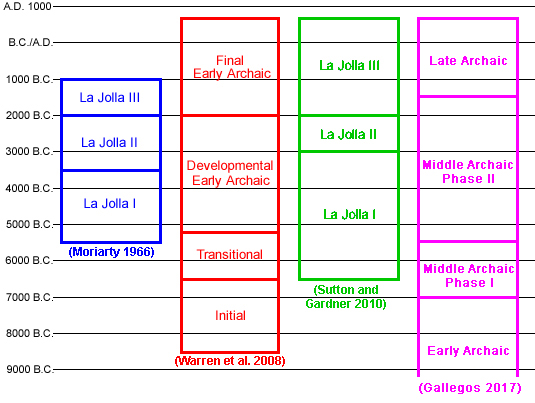La Jolla Phases
Phases Within the La Jolla Period
- Malcolm J. Rogers (1945) proposed two developmental phases, which at various times he designated as La Jolla and Encinitas, Littoral I and II, and La Jolla I and II (Harding 1951). La Jolla II was said to be distinguishable from La Jolla I by an increase in flaked lithic artifacts, an increase in the use of metates, a tendency to segregate burials into cemeteries, and a decrease in the long-headedness (dolichocephaly) of human skulls.
- Mabel Harding (1951) noted three components at a La Jolla site in Sorrento Valley. The lowest stratum generally lacked groundstone, chopping tools, planes, and projectile points. The middle stratum contained all of these classes of tools. The upper stratum included somewhat more finely flaked tools and at least one side-notched point.
- George Shumway, Carl L. Hubbs, and James R. Moriarty, III (1961:118) questioned the validity of the ways Rogers and Harding had characterized patterns of change during the span of the La Jolla Complex. They noted that the Scripps Estate Site, which was placed early in the La Jolla sequence on the basis of radiocarbon dates, contained an area of concentrated burials and an abundance of flaked stone tools, which were supposed to be characteristics of later phases.
- Claude N. Warren (1964) also critically evaluated previous La Jolla phase proposals and found little empirical evidence to support them. He did note a few subtle changes in Intermediate Period (post-1000 B.C.) assemblages, including the advent of the mortar and pestle and a slight increase in the frequency of projectile points.

- Moriarty (1966) proposed the existence of three distinguishable phases: La Jolla I (ca. 5500-3500 B.C.), La Jolla II (ca. 3500-2000 B.C.), and La Jolla III (ca. 2000-1000 B.C.). The second phase was said to be differentiated from the first by the presence of drilled and polished stone artifacts (beads, pendants, discoidals, and balls), by the reappearance of projectile points and varied and well-made bifacially worked tools (present in the earlier San Dieguito complex but not in La Jolla I), and by orientation of burials, their organization into cemeteries, and the general presence of mortuary offerings. La Jolla III was distinguished by the placement of sites at lower elevations and by a well-developed association of food refuse with burials.
- Warren, Gretchen Siegler, and Frank Dittmer (2008) recognized four early periods: an Initial Period (ca. 8500-6200 B.C.), including both San Dieguito assemblages and some La Jolla assemblages; a Transitional Period (ca. 6200-5200 B.C.), with both Transitional San Dieguito/La Jolla assemblages and purely La Jolla assemblages; a Developmental Early Archaic Period (ca. 5200-2000 B.C.), representing the main florescence of the La Jolla pattern; and a Final Early Archaic Period (ca. 2000 B.C. to A.D. 700), with La Jolla assemblages somewhat modified by environmental changes and by Campbell Tradition influences.
- Mark Q. Sutton and Jill K. Gardner (2010) returned to the three La Jolla phases and their definitions that had been suggested by Moriarty (1966), but with substantially modified time ranges for the phases.
- Dennis R. Gallegos (2017) also distinguished four periods prior to A.D. 700. These were Early Archaic (10,000-7000 B.C.), representing the initial occupations of the region; Middle Archaic Phases I and II (7000-5500 B.C. and 5500-1500 B.C., respectively), characterized by stability but with some change; and Late Archaic (1500 B.C.-A.D. 700), marked in some areas by resource depletion, associated depopulation, and population movement.
PROSPECTS
Future archaeological investigations may be able to test the various proposed changes through time in La Jolla cultural patterns and to discover additional chronologically diagnostic artifacts, features, and other elements. Studies may be able to determine whether changes during the middle Holocene were staggered and gradual, indicating cultural continuity, or whether there were abrupt discontinuities suggestive of ethnic replacement, an influx of additional groups, or general cultural reorganization.